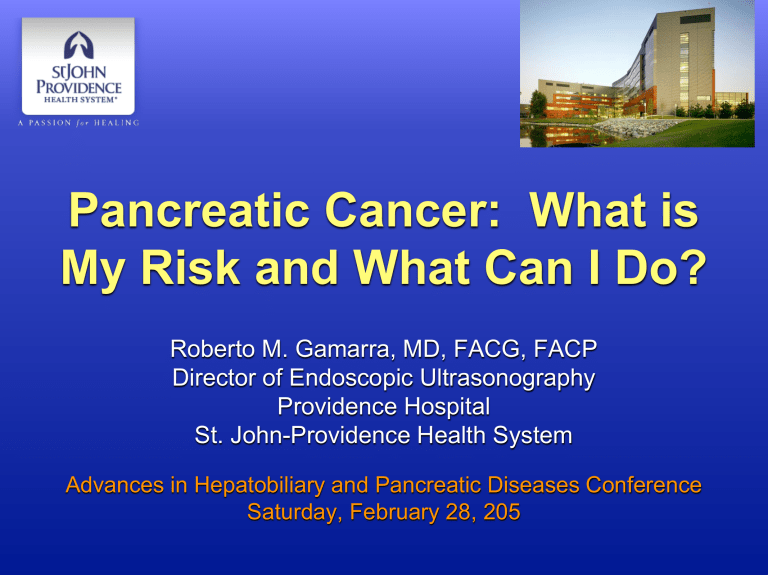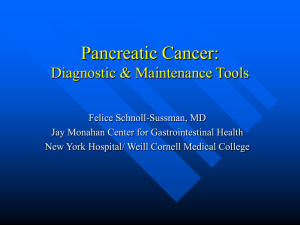Pancreatic Cancer - St. John Providence

Pancreatic Cancer: What is
My Risk and What Can I Do?
Roberto M. Gamarra, MD, FACG, FACP
Director of Endoscopic Ultrasonography
Providence Hospital
St. John-Providence Health System
Advances in Hepatobiliary and Pancreatic Diseases Conference
Saturday, February 28, 205
Disclosures
• Speaker bureau for Boston Scientific
What Everyone Always Pictures
What Everyone Should Know
• There is always hope!
• A multi-disciplinary team approach is fundamental
(gastroenterology, surgery, medical oncology, radiation oncology, radiology, pain medicine, dietitians, palliative care experts, and specialty nursing)
• Experience matters!
Introduction to
Pancreatic Cancer
Pancreatic Cancer Statistics
• Prevalence = 43,538 living with pancreatic cancer in US
• # new cases = 12.3 per 100,000
• # deaths = 10.9 per 100,000
• Lifetime risk of developing pancreatic cancer = 1.5%
Pancreatic Cancer Statistics
9
10
-
6
7
8
1
2
3
4
5
12
COMMON CANCERS
PROSTATE
BREAST CANCER (FEM)
LUNG
COLORECTAL
MELANOMA
BLADDER
NON-HODGKIN
KIDNEY/RENAL PELVIS
THYROID
ENDOMETRIAL
-
PANCREATIC
ESTIMATED NEW
CASES IN 2014
233,000
232,670
224,210
136,830
76,100
74,690
70,800
63,920
62,980
52,630
-
46,420
ESTIMATED DEATHS
IN 2014
29,480
40,000
159,260
50,310
9,710
15,580
18,990
13,860
1,890
8,590
-
39,590
•
What Everyone Should Know
4th leading cause of cancer death
• No single reliable screening test for early detection
Pancreatic Cancer Statistics
Cases and Death Rates
Rates of new cases have not changed
Death rates have been increasing about 0.4% per year between 2004-2011
Pancreatic Cancer Statistics
5-Year Survival Rates: All Cancer & Pancreatic Cancer
Death rates have been increasing about 0.4% per year between 2004-2011
Pancreatic Cancer Statistics
Survival by Stage
Pancreatic Cancer Statistics
Who Gets of Pancreatic Cancer?
98%
90%
70%
What is My Real Risk?
1-year risk Lifetime risk
What Causes Pancreatic
Cancer?
What Causes Pancreatic Cancer?
• Damage to DNA of pancreatic ductal or acinar cells
• Can be inherited or acquired
• Chance mutations
What Causes Pancreatic Cancer?
What Risk Factors Lead to
Pancreatic Cancer?
Risk Factors
<5% LIFETIME RISK 5-10% LIFETIME RISK >10% LIFETIME RISK
Male gender
Black race
Ashkenazi Jew
Familial adenomatous polyposis (FAP)
BRCA1
Non-O blood type?
2 FDRs with PC
Cystic fibrosis
BRCA2
PALB2
Li-Fraumeni syndrome
Ataxia telangiectasia
3 FDRs
Peutz-Jeghers syndrome
Hereditary pancreatitis
FAMMM
Smoking (3.7x)
Diabetes mellitus (2x)
Obesity (1.7x)
Heavy alcohol use
H. pylori and Hep B
Exposure to chemicals
Chronic pancreatitis
Adapted from Brand R, et al. Gut 2007
How Much Does My Family
History Affect My Risk?
CATEGORY
Overall
3+ FDRs
2 FDRs
1 FDR
Young onset kindred
Late onset kindred
SIR
6.79 (4.54-9.75)*
17.02 (7.34-33.5)*
3.97 (1.59-8.2)*
6.86 (3.75-11.04)%
9.31 (3.42-20.2)*
6.34 (4.02-9.51)*
Brune, et al. NJCI 2010
Risk Factors
INDIVIDUAL
No history
1 FDR
2 FDRs
3 FDRs
Breast-Ovarian CA
FAMMM
Hereditary panc
Peutz-Jeghers
Lynch syndrome
GENE
None
?
?
?
BRCA1
BRCA2 p16/CDKN2A
PRSS1
STK11/LKB1
MLH1,MSH2
RR
1
2.3
6.4
32
2
5-10
20-34
50-80
132
10
RR 5-10%
RR >10%
RISK BY AGE 70
0.5%
1.15%
8-12%
16-32%
1%
5%
10-17%
25-40%
30-60% (36%)
5%
Pancreatic Cancer
5-Year Survival Correlates with T Stage
Carcinoma in situ
Minute
<1 cm
T1
<2 cm
Large
Resectable
Unresectable
100%
85%
20-40%
5-Year Survival 10-20%
0-2%
Chari, et al. Sem Oncol 2007
Compton CC, Mulvihill SJ. Prognostic factors in pancreatic carcinoma. Surg Oncol Clin N Am 1997; 6:533-54
Paradigm Shift is Needed
• No change in mortality over decades
- Unlike breast lung, breast, and colon cancer!
• No major advances in pancreatic cancer treatments
- Modest advances in chemotherapy and surgical techniques
- Little impact on survival
Should We Screen?
• Rare cancer (1:10,000 cases per year)
• 90% are sporadic
• Testing is difficult
• Testing is invasive and can cause harm
• Testing not cheap
• No proof it reduced mortality
Screening May Be Cost Effective
• Decision analysis study using 1-time screening using EUS in
100 familial pancreatic cancer kindred patients
• Cost effective if prevalence is >16% and sensitivity of EUS is
>84%
• Almost $17,000 per life-year saved
Rulyak SJ, et al. Cost-effectiveness of pancreatic cancer screening in familial pancreatic cancer kindreds. GIE 2003; 57:23-9
Renewed Interest in Screening for Pancreatic Cancer
• Better understanding of pathogenesis and natural history
• Estimated accumulations of mutations
- 11.7 years until overt cancer
- Another 6.8 years until overt metastases
• Improved resolution of EUS, CT, and MRI
• Improved EUS-FNA and cytology processing techniques
• Advances in molecular testing and cytogenetics
Yachida S, Jones S, Bozic I, et al. Distant metastasis occurs late during the genetic evolution of pancreatic cancer. Nature
2010; 467:1114-7
Precursor Lesions
Precursor Lesions
IPMN
Easily visible
MUCINOUS CYSTIC
NEOPLASM (MCN)
Easily visible
PANIN
Microscopic
15%
Most common lesion diagnosed!
0-5%
99% women
80-85%
Difficult to find!
PanIN Lesions
Text
PanIN Lesions
PanIN Lesions
Pancreatic Cancer Screening:
The Data
Clinical Studies
• To date, 13 published studies on pancreatic cancer screening limited to high-risk individuals
• All studies used EUS as test of choice
• Screening is safe
• Most clinically important lesions found at index study
• Limited by benign lesions with malignant potential requiring work up
MRI-based
Clinical Studies
EUS-based
STUDY INSTITUTION #HRI GROUPS IMAGING
BRENTNALL 1999 U of Washington 14
KIMMEY 2002 U of Washington 46
FPC
FPC
EUS+ERCP+C
T
EUS+ERCP
CANTO 2004
CANTO 2006
Johns Hopkins
Johns Hopkins
38
78
FPC, PJS
FPC, PJS
EUS, ERCP,
CT
EUS, ERCP,
CT
POLEY 2009 Rotterdam 44
FPC, BRCA, PJS, p16, p53, HP
EUS, CT, MRI
LANGER 2009 Marburg 76 FPC, BRCA
EUS+MRI, EUS-
FNA
VERNA 2010
LUDWIG 2011
VASEN 2011
Columbia
Sloan Kettering
Leiden U
51 FPC, BRCA, p16 EUS+/-MRCP
109
77
FPC, BRCA p16
MRCP+/-EUS+/-
FNA
MRI/MRCP
AL-SUKHNI 2011 U of Toronto 262
FPC, BRCA 1/2,
PJS, p16, HP
SCHNEIDER 2011 German Nat’l
CANTO 2012
DELCHIARO 2013
72 FPC
Johns Hopkins
Sweden
216
FPC, PJS,
BRCA
40 FPC,BRCA1/2,p16
MRI, CT, EUS,
ERCP
EUS+MRCP
CT, MRI/MRCP,
EUS, ERCP
MRI
#PREMALIG # MALIG YIELD
7
12
1
6
7
1
4
7
9
16
2
92
14
0
0
1
1
3
0
2
1
7
3
1
0
2
50%
26%
5.3%
10.3%
23%
1.3%
12%
8.3%
20%
7.3%
4%
43%
40%
CAPS2 Study
Johns Hopkins University
• 2 high risk groups: PJS (group 1) and familial pancreatic cancer kindreds (group 2)
• Baseline:
- Baseline screening evaluation and at least 1 follow up clinical and radiologic (EUS and CT) within 1 year
- Genetic counseling
- If abnormal EUS, then CT and possibly ERCP
• Surgery offered for mass, large cysts, mural nodules, or severe dysplasia on FNA
Canto MI, et al. Screening for early pancreatic neoplasia in high risk individuals: a prospective controlled study. Clin
Gastroenterol Hepatic 2006; 4:766-81
•
CAPS2 Study
Johns Hopkins University
8 of 78 (10.2%) patients had pancreatic neoplasia
- 1 PJS with IPMN with carcinoma in situ resected
- 1 FPC with 3FDRs with IPMN x 2 and multifocal PanIN3 resected
- 1 FPC with 3 relatives with multifocal PanIN1/2 resected
- 1 FPC with 4 relatives with chronic pancreatitis and panIN1/2 resected
- 1 FPC with 3 relatives/BRCA2 with chronic pancreatitis and IPMNs x 2
- 1 FPC with 3 relatives with IPMN and PanIN1
- 1 FPC with 5 relatives/BRCA2 IPMN advised for surgery
- 1 FPC with 4 relatives with IPMN and PanIN1-3
Canto MI, et al. Screening for early pancreatic neoplasia in high risk individuals: a prospective controlled study. Clin
Gastroenterol Hepatic 2006; 4:766-81
•
CAPS2 Study
Johns Hopkins University
6 PJS and 72 familial pancreatic cancer vs. 149 controls
• 3 extra-pancreatic cancers
• 1 patient with IPMN refused surgery and developed metastatic pancreatic cancer
• Proof: Premalignant lesions can be identified
• Proof: At-risk patients can be identified
• Proof: Intervention can prevent malignancy
Canto MI, et al. Screening for early pancreatic neoplasia in high risk individuals: a prospective controlled study. Clin
Gastroenterol Hepatic 2006; 4:766-81
Columbia University
Patients & Protocol
• Prospective study of 51 patients [FPC, BRCA 1/2, PJS,
FAMMM, Lynch, hereditary pancreatitis]
• All patients with family history and interest in risk of disease offered enrollment
• H&P, family history by genetic counselor, results of all imaging and blood testing, storage of frozen serum and any surgically resected tissue
• Blood processed for DNA extraction and EBV immortalization
Verna EC, et al. Pancreatic cancer screening in a prospective cohort of high-risk patients: a comprehensive strategy of imaging and genetics. Clint Cancer Res 2010; 16(2): 5028-37
Columbia University
H&P, PE, family history, genetic testing
Avg Risk:
1 relative >55yo
Moderate Risk:
>=2 FDR, SDR or TDR
1FDR <55yo
High Risk:
>=3 FDR, SDR, TDR
>=2 FDR
1FDR+1SDR w/ 1<55yo
Genetic syndrome
Basic labs,
Additional testing if indicated
EUS or MRI
CA 19-9 & OGTT
EUS or MRI
CA 19-9 & OGTT
No malignant or premalignant disease identified
Any abnormal testing:
EUS
(if not already done)
(+/- FNA and ERCP)
Malignant or premalignant disease diagnosed or suspected
Surveillance Consider surgery
Verna EC, et al. Pancreatic cancer screening in a prospective cohort of high-risk patients: a comprehensive strategy of imaging and genetics. Clint Cancer Res 2010; 16(2): 5028-37
Columbia University
Genetics Testing
• 24 (47%) had genetic testing: 7 positive for BRCA 1/2
- BRCA 1 and 2
- MMR testing
- CDKN2A/p16
• Counseling before and after testing by genetics counselor
• Prophylactic mastectomy, oophorectomy, chemoprevention and enhanced screening discussed
Verna EC, et al. Pancreatic cancer screening in a prospective cohort of high-risk patients: a comprehensive strategy of imaging and genetics. Clint Cancer Res 2010; 16(2): 5028-37
Columbia University
Follow Up
• Weekly multidisciplinary meeting
• Screening started 10 years before youngest affected family member
• Follow up:
- High risk: Every 6 months with alternating EUS and MRI
- Moderate risk: Every 1 yr with alternating EUS and MRI
- Average risk: No imaging. Annual visits and further testing if they developed symptoms or new onset DM
Verna EC, et al. Pancreatic cancer screening in a prospective cohort of high-risk patients: a comprehensive strategy of imaging and genetics. Clint Cancer Res 2010; 16(2): 5028-37
Columbia University
Results
• 51 patients from 43 families
- 90% non-Hispanic whites, 35% male, 35% tobacco hx
- 29% personal history of cancer other than pancreatic
• Family history: 15 (29%) >2 FDRs; 35 (69%) >2 relatives
• Categories: 32 (69%) high risk, 14 (27%) moderate risk, 5
(10%) avg risk
• 61% had EUS and 65% had MRI/MRCP
Verna EC, et al. Pancreatic cancer screening in a prospective cohort of high-risk patients: a comprehensive strategy of imaging and genetics. Clint Cancer Res 2010; 16(2): 5028-37
Columbia University
Results
OVERALL (51) AVG RISK (5)
MODERATE
RISK (14)
EUS: CHRONIC PANC
CHANGES
6/31 (19%) 1/2 (50%) 0/5 (0%)
5/31 (16%) 0/2 (0%) 2/5 (40%) EUS: IPMN
EUS: SOLID MASS
ERCP: PD IRREG
ERCP: IPMN
MRI/MRCP: PD IRREG
MRI/MRCP: IPMN
MRI/MRCP: SOLID MASS
5/24 (21%)
2/31 (6%) 0/2 (0%) 0/5 (0%)
2/7 (29%) 1/1 (100%) 0/1 (0%)
4/7 (57%) 0/1 (100%) 1/1 (100%)
1/33 (3%) 0/3 (0%) 0/7 (0%)
1/33 (3%)
3/33 (9%)
5/51 (10%)
0/3 (0%)
1/3 (33%)
0/5 (0%)
1/7 (14%)
0/7 (0%)
3/24 (13%)
2/24 (8%)
1/5 (20%)
3/5 (60%)
1/23 (4%)
0/23 (0%)
2/23 (9%)
2/14 (14%) 3/32 (10%) PANCREAS SURGERY
HIGH RISK
(32)
Verna EC, et al. Pancreatic cancer screening in a prospective cohort of high-risk patients: a comprehensive strategy of imaging and genetics. Clint Cancer Res 2010; 16(2): 5028-37
Columbia University
• Results:
- 2 (4%) pancreatic CA (FPC and BRCA2), 5 (10%)
IPMNs, 7 cysts
- 4 extrapancreatic tumors: 2 ovarian CA, 1 carcinoid, 1 papillary thyroid carcinoma
• 12% diagnosed with malignant/premalignant disease of pancreas
• 18% diagnosed with malignant/premalignant disease of any organ
Verna EC, et al. Pancreatic cancer screening in a prospective cohort of high-risk patients: a comprehensive strategy of imaging and genetics. Clint Cancer Res 2010; 16(2): 5028-37
•
CAPS4
Johns Hopkins University
Prospective observational cohort study
• Study the diagnosis and long-term outcomes of screening patients with increased risk for pancreatic cancer
HIGH RISK GROUPS
Group 1: Peutz-Jeghers Syndrome
(PJS)
Group 2: Familial pancreatic cancer
Group 3: Germline mutations:
BRCA1, BRCA2, PALB2, PRSS1, p16
Group 4: Young-onset pancreatic cancer relative
Group 5: Both parents affected
Not yet completed
CONTROLS
Group 1: Negative controls
Group 2: Chronic pancreatitis
Group 3: Pancreatic cancer
Group 4: IPMN
CAPS Consensus Summit
50 experts from 10 different countries
• What to start? 40 or 10 years prior to youngest relative?
• How to screen? EUS? MRI/MRCP? CT? ERCP?
• How often to follow? Once only? Yearly? Every other year?
• When to resect? How much to resect?
• >75% agreement considered consensus
Canto MI, Harnick F, Hruban RH, et al. International cancer of the pancreas screening (CAP) consortium summit on the management of patients with increased risk for familial pancreatic cancer. Gut 2013; 62:339-47
CAPS Consensus Summit
Who Should Be Screened?
HIGH RISK GROUP > 75% CONSENSUS
2+ relatives with/without FDR
Peutz-Jeghers syndrome
BRCA2 with >1 FDR p16 with >1 FDR
Lynch syndrome with >1 FDR
PALB2 with >1 FDR
BRCA2 without family history
BRCA1
Young onset pancreatic cancer
New-onset DM
92%/78%
96%
86%
88%
88%
78%
51.1%
69.4%
No
No
Canto MI, Harinck F, Hruban RH, et al. International cancer of the pancreas screening (CAP) consortium summit on the management of patients with increased risk for familial pancreatic cancer. Gut 2013; 62:339-47
CAPS Consensus Summit
How Should Patients Be Screened?
SCREENING MODALITY > 75% CONSENSUS
Initial screen with EUS (MRI/MRCP)
F/u of normal with EUS (MRI/MRCP)
In normal tests, f/u should be every 1 year
84% (74%)
79% (70%)
73%
Benign cysts followed every 6-12 mo
Indeterminate lesions followed at 3 mo
ERCP should NOT be performed as an additional test for solid/cystic lesions
CT should be performed for EUS abnormalities
Initial screen with US, CT, or ERCP
84%
86%
77.5%/77.%
Yes
No
FNA of cysts should be performed No
Canto MI, Harinck F, Hruban RH, et al. International cancer of the pancreas screening (CAP) consortium summit on the management of patients with increased risk for familial pancreatic cancer. Gut 2013; 62:339-47
CAPS Consensus Summit
When Should Surgery Be Offered?
• Screening should only be offered to patients who are candidates for surgery (75.5%)
• Most lesions found are IPMNs
• Resection for:
- Symptomatic lesions
- >3 cm
- Mural nodules
• Surgery should be considered for suspected IPMNs >2 cm
Canto MI, Harinck F, Hruban RH, et al. International cancer of the pancreas screening (CAP) consortium summit on the management of patients with increased risk for familial pancreatic cancer. Gut 2013; 62:339-47
CAPS Consensus Summit
When Should Surgery Be Offered?
SCREENING MODALITY
Screen only if surgical candidate
Surgery only at high-volume centers
Continue surgery until R0 resection
Stop resection in unifocal PanIN2
Stop resection if <HGD
Repeat surgery if PanIN3 at margin post-op
> 75% CONSENSUS
76%
100%
76%
78%
78%
No
Canto MI, Harinck F, Hruban RH, et al. International cancer of the pancreas screening (CAP) consortium summit on the management of patients with increased risk for familial pancreatic cancer. Gut 2013; 62:339-47
CAPS Consensus Summit
When is Screening Considered a Success?
SCREENING MODALITY
T1N0M0 at baseline/follow-up
Any stage pancreatic cancer at baseline
Multifocal PanIN-3
Unifocal PanIN-3
IPMNs with HGD
IPMNs without HGD
Pancreatic NETs
> 75% CONSENSUS
90%/78%
90%
84%
74%
96%
No
No
Canto MI, Harinck F, Hruban RH, et al. International cancer of the pancreas screening (CAP) consortium summit on the management of patients with increased risk for familial pancreatic cancer. Gut 2013; 62:339-47
What Can I Do to Reduce My
Risk?
What Can I Do to Reduce My
Risk of Pancreatic Cancer?
• Avoid all tobacco
• Lose weight with diet and exercise
What Can I Do to Reduce My
Risk of Pancreatic Cancer?
• Diets high meat, cholesterol, fried foods, nitrosamines vs. diets high in fruits/vegetables
What Can I Do to Reduce My
Risk of Pancreatic Cancer?
• Avoid all tobacco
• Lose weight with diet and exercise
• Do not drink alcohol in excess
• Control my diabetes
• Know my family history: breast, colon, skin cancer
• Eradicate H. pylori & vaccinate for hepatitis B
• Avoid occupational chemicals
What Can I Do to Reduce My
Risk of Pancreatic Cancer?
Screening is NOT Recommended for…
• Common medical conditions: obesity, diabetes, smokers, chronic pancreatitis
• Family history: 1 FDR with pancreatic cancer >50 years old,
2 SDRs with pancreatic cancer
• Genetic syndromes: hereditary pancreatitis, cystic fibrosis,
FAP, Li-Fraumeni syndrome, ataxia-telangiectasia
What Can I Do to Reduce My
Risk of Pancreatic Cancer?
Consider Enrolling in Screening Program if…
• Family history: 2+ FDRs or 2 relatives with 1 FDR or 1 FDR
<50 years old
• Common genetic syndromes: BRCA2, PALB2, BRCA1 w/ family history, Lynch syndrome
• Rare genetic syndromes: Peutz-Jeghers and FAMMM
Summary
• Pancreatic cancer is rare and the risk for most people is low
• All people can reduce their risk with lifestyle modifications
• There are pancreatic cancer precursors that are difficult but not impossible to discover with current imaging
• Pancreatic cancer screening in high risk individuals is recommended
• EUS and MRI/MRCP are the preferred imaging modalities for looking for pancreatic cancer precursors and early pancreatic cancer
What Everyone Should Know
• There is always hope!
• A multi-disciplinary team approach is fundamental
(gastroenterology, surgery, medical oncology, radiation oncology, radiology, pain medicine, dietitians, palliative care experts, and specialty nursing)
• Experience matters!
Thank You!
University of Washington
• 14 patient from 3 kindreds with a history of pancreatic cancer
• CT, CA 19-9, CEA, EUS, ERCP on all patients
• 7 of 14 thought to have dysplasia and referred to pancreatectomy
• CT had low sensitivity; EUS findings similar to chronic pancreatitis
• All 7 of 14 had widespread dysplasia
Brentnall T, et al. Early diagnosis and treatment of pancreatic dysplasia in patients with family history of pancreatic cancer.
Ann Intern Med 1999;131:147-55
University of Washington 2
• 46 patients from 1 kindred with history of pancreatic cancer
• Observational study
• CT, MRI, PET, EUS, and ERCP
- EUS: 24 of 46 (%) abnormal
- ERCP: 13 of 28 (%) abnormal
• 12 of 12 (100%) of surgery had widespread dysplasia
Kimmey, MB, et al. Screening and surveillance for hereditary pancreatic cancer. Gastronintest Endosc 2002; 56(4)(suppl):
S82-86
CAPS1 Study
Johns Hopkins University
• 38 asymptomatic patients: 31 (>3 relatives), 6 (2 relatives),
1 PJS underwent screening with EUS and ERCP
• 6 masses: 1 invasive cancer (FPC), 1 IPMN (PJS), 2 serous cystadenomas, 2 non-neoplastic masses
• Yield = 2 of 38 (5.3%)
• 1 cancer patient treated and was alive at >5 years
• 2 of 24 (8.3%) had post-ERCP pancreatitis
Canto MI, et al. Screening for pancreatic neoplasia in high risk individuals: an EUS-based approach. Clin Gastroenterol
Hepatic 2004; 2:606-21
Dutch Study
Erasmus Medical Center, Rotterdam, Netherlands
• 44 patients: 21 FDRs, 3 BRCA 1, 2 BRCA2, 2 hereditary pancreatitis, 2 PJS, 13 FAMMM, 1 p53
• Screening EUS, CT, MRI
• 3 (6.8%) masses: 3 cancers (1 BRCA2 and 2 FAMMM)
• 7 (15.9%) branched duct IPMNs
Poley JW, et al. The yield of first-time endoscopic ultrasonography in screening individuals at high risk of developing pancreatic cancer. Am J Gastroenterol 2009; 104:2175-81
German Study
Philipps University, Marburg, Germany
• 76 HRIs in families with FPC in FaPaCa Registry
• Clinical exam, labs, EUS, MRI/MRCP and MRA
• Abnormal in 28 of 76 (37%): 25 EUS and 12 MRI/MRCP
• 7 had FNAs, 7 had surgery with 6 limited resections
• All 6 lesion benign: 3 SCAs, 1 PanIN1, 1 PanIN2, 1 IPMN
• Screening is not justified
Langer P, et al. Five yers of prospective screening of high risk individuals from families with familial pancreatic cancer. Gut
2009; 58:1410-18
Sloan Kettering Study
Text
• 309 at risk relatives form Familial Pancreatic Tumor Registry
- Early pancreatic cancer, 2+ relatives, 3+ SDRs, BRCA 1/2 with family history
• MRI/MRCP yearly followed by EUS if abnormal
- 18/109 (16.5%) abnormal; 15 underwent EUS
• Diagnostic yield: 9/109 (8.3%), 6 resected
- 1 T3N0 pancreatic cancer, 2 IPMNs, 1 PanIN3, 1 PanIN2,
1 serous cystadenoma), 3 suspected IPMNs not resected
Ludwig E, et al. Feasibility and yield of screening in relatives from familial pancreatic cancer families. Am J Gastroenterol
2011; 106:946-54
Dutch Study 2
Leiden University Medical Center, Netherlands
• p16 = CDKN2A leads to FAMMM
• 77 patients underwent annual MRI/MRCP
- If abnormal, offered surgery or intensive follow up
• Pancreatic cancer 7 of 77 (9%) (3 prevalent and 4 incident) all resectable
- 9 more patients had possible precursor lesions
Vasen HFA, et al. magnetic resonance imaging surveillance detects early stage pancreatic cancer in carriers of p16 Leiden mutation. Gastroenterol 2011; 140:850-6
Canadian Study
University of Toronto
• Prospective cohort study
• 262 FPC, FAMMM, PJS, BRCA 1 w/ FHx, BRCA2
• MRI/MRCP annually; consider EUS, ERCP, CT, or rpt MRI
- 3 advanced pancreatic CA, 1 NET, 15 IPMNs, 65 cysts
• Only 4/262 (1.5%) underwent surgery
Al-Sukhni W, et al. Screening for pancreatic cancer in a high risk cohort: an eight-year experience. J Gastrointest Surg 2012;
16:771-83
German Study 2
Philipps University, Marburg, Germany
• 94 of 284 families fulfilled inclusion criteria in FaPaCa
- 72 patients in 284 families enrolled in FaPaCa registry
• EUS and MRI/MRCP
• Pancreatic CA or IPMN or multifocal PanIN2/3 in 4 of 72
(5.5%) of resected specimens or 9 (12.5%) of suspected lesions
Schneider R, et al. German national case collection for familial pancreatic cancer (FaPaCa): ten year experience. Familial
Cancer 2011; 10:323-30
CAPS3 Study
Johns Hopkins University
CT MRI/MRCP LESION EUS
ANY
SOLID
11% (24/216)
1.4% (3/216)
33.3% (72/216) 42.5% (92/216)
0.4% (1/216) 1.4% (3/216)
CYSTIC
COMMUNICATION
W/ PD
MURAL NODULE
11% (24/216)
36%
4.2%
(8/24)
(1/24)
33%
53%
(72/216)
(38/72)
36%
27%
(79/216)
(21/79)
1.4% (1/72) 3.8% (3/79)
PD DILATION 2.4% (5/216) 2.4% (5/216) 9.5% (21/216)
Canto MI, et al. Frequent detection of pancreatic lesions in asymptomatic high-risk individuals. Gastroenterol 2012; 142:796-
804
Swedish Study
Swedish Study
• 2010 to 2013
• MR-based surveillance program
• 40 patients with mean follow-up 12.9 months
• Familial [5 in 2 pts (5%), 4 in 5 pts (12.5%), 3 in 17 pts (42.5%), 2 in 14 pts (35%) and 1 in 2 pts (5%)]
• Cytogenetics: p16 (4 pts(10%)), BRCA2 (3 pts (7.5%)), BRCA1 (1 pt
(2.5%))
• Suspicious lesion in 16 pts (40%): IPMN [14 (35%)], Cancer [2 (5%)]
Abstrct: Del Chiaro M, et al. J Pancreas JOP 2013 Sep 15; 14:540
Text
Text



